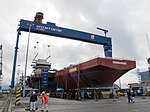Rosyth Dockyard
1909 establishments in ScotlandEconomy of FifeOrganisations based in FifePages including recorded pronunciationsPort cities and towns of the North Sea ... and 6 more
Ports and harbours of ScotlandRosythRoyal Navy bases in ScotlandRoyal Navy dockyardsRoyal Navy submarine basesUse British English from January 2015

Rosyth Dockyard is a large naval dockyard on the Firth of Forth at Rosyth, Fife, Scotland, owned by Babcock Marine, which formerly undertook refitting of Royal Navy surface vessels and submarines. Before its privatisation in the 1990s it was formerly the Royal Naval Dockyard Rosyth. Its primary role now is the dismantling of decommissioned nuclear submarines. It is also the integration site for the Royal Navy's newest aircraft carriers, the Queen Elizabeth class as well as the Type 31 Frigate.
Excerpt from the Wikipedia article Rosyth Dockyard (License: CC BY-SA 3.0, Authors, Images).Rosyth Dockyard
Maitland Road,
Geographical coordinates (GPS) Address Nearby Places Show on map
Geographical coordinates (GPS)
| Latitude | Longitude |
|---|---|
| N 56.020555555556 ° | E -3.4533333333333 ° |
Address
Maitland Road
Maitland Road
KY11 2EA
Scotland, United Kingdom
Open on Google Maps







